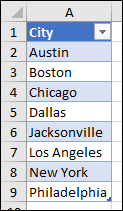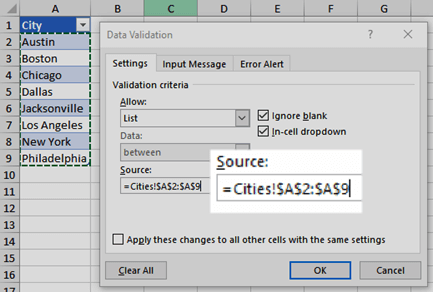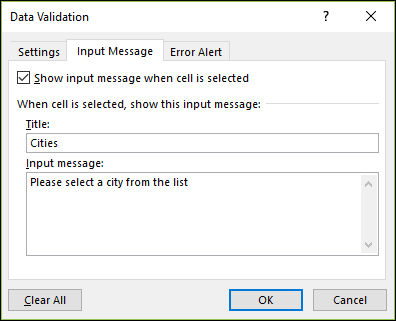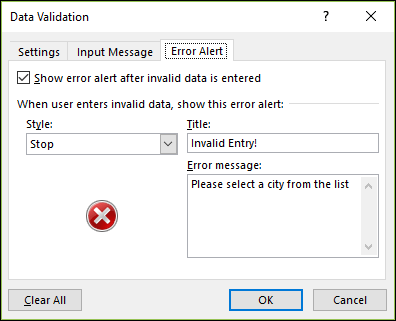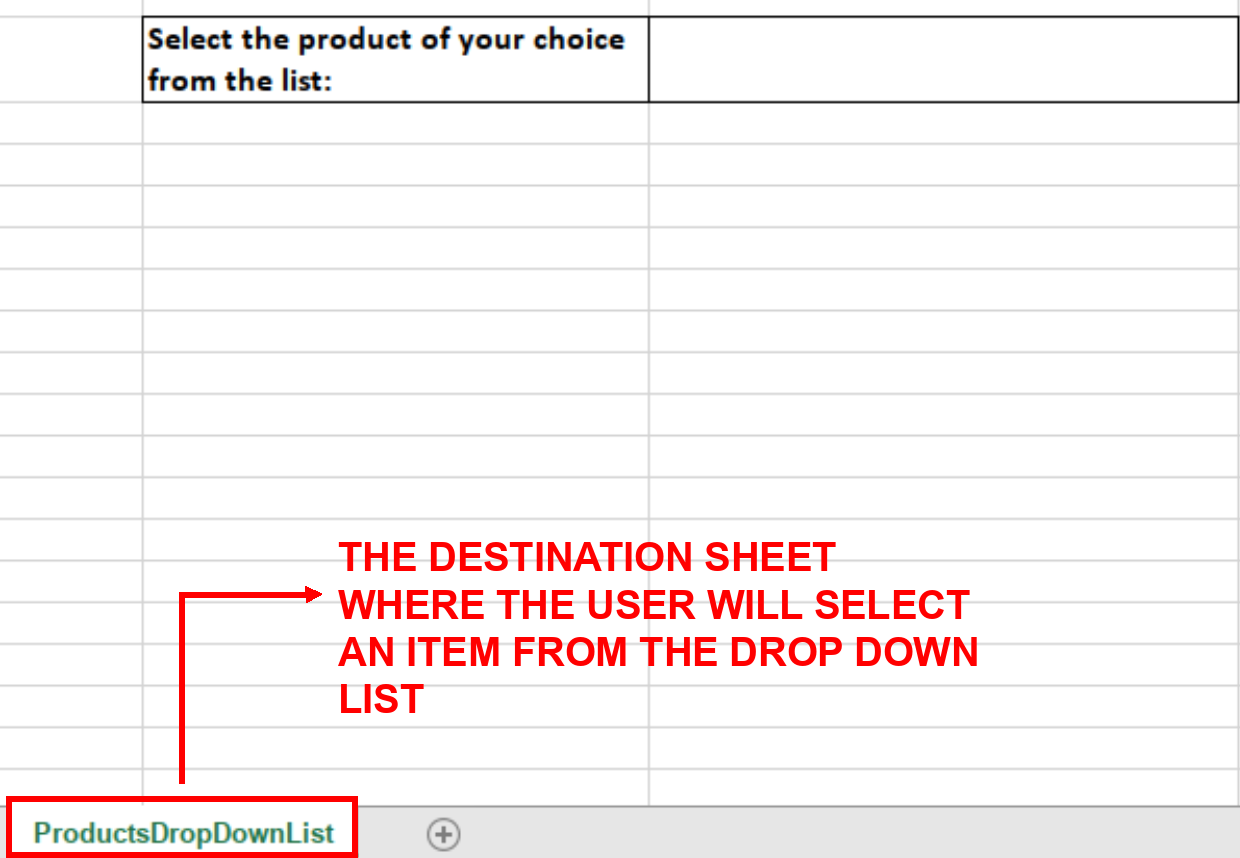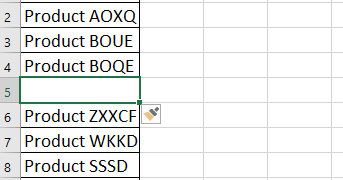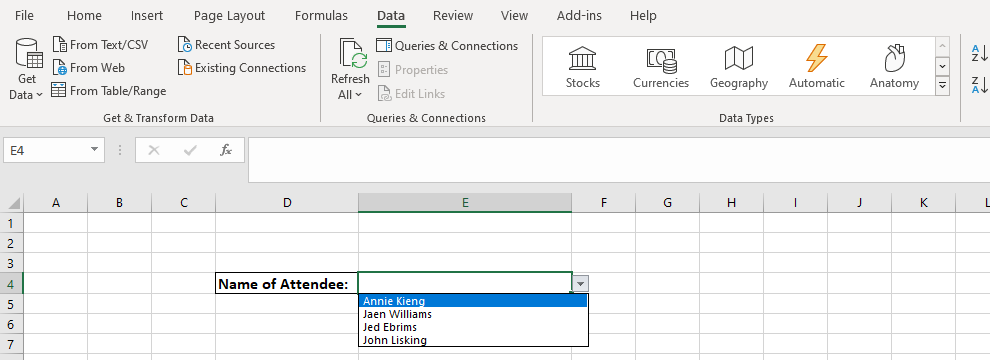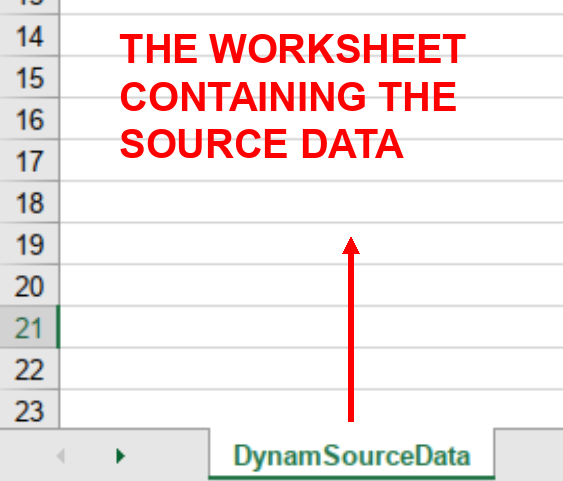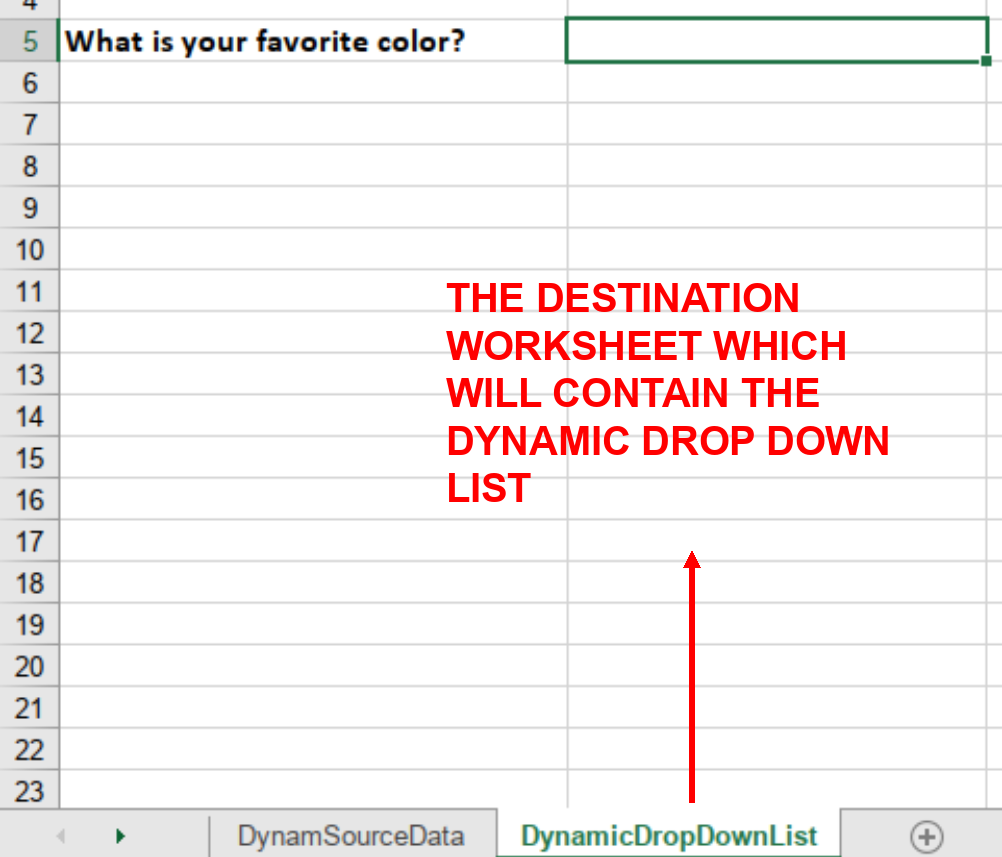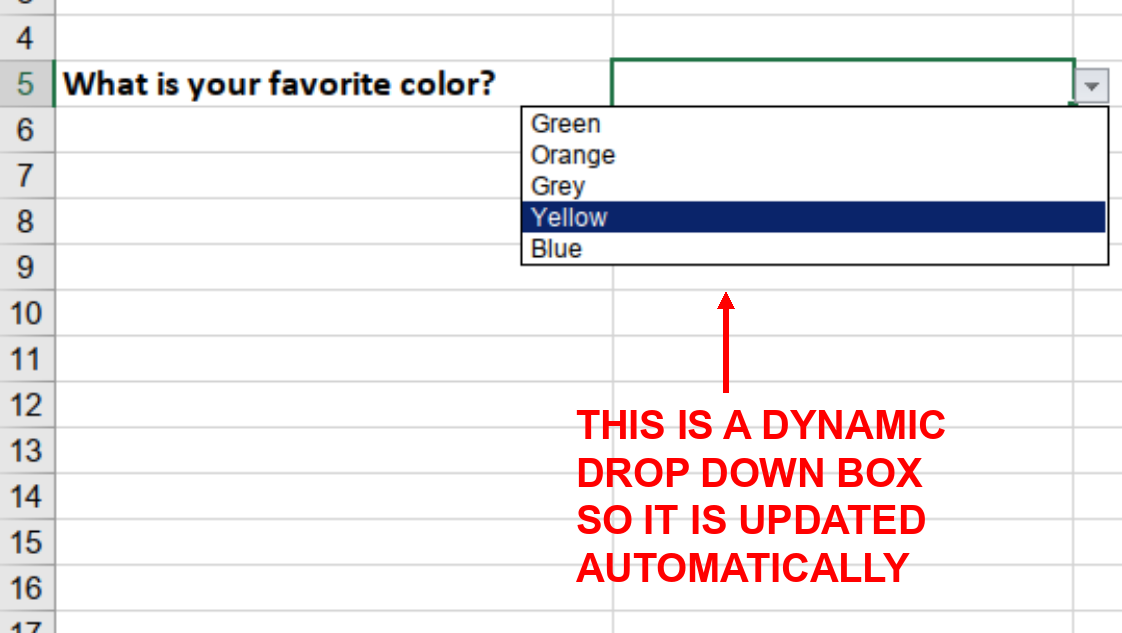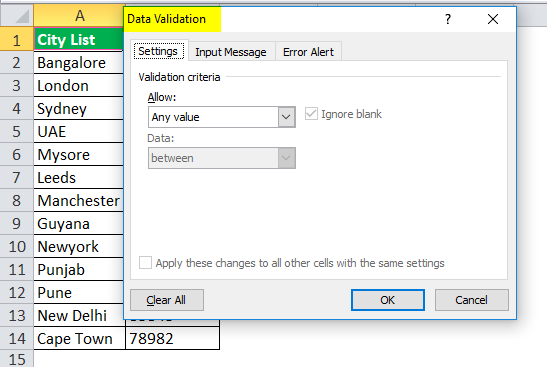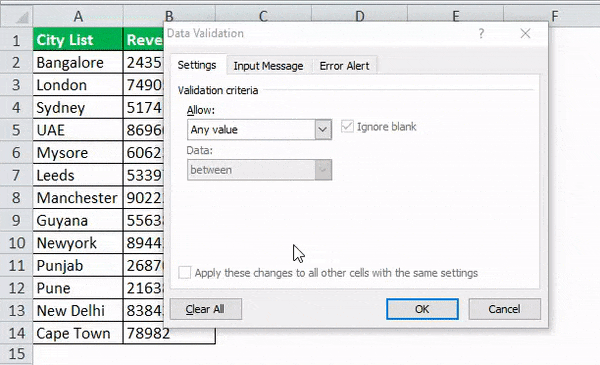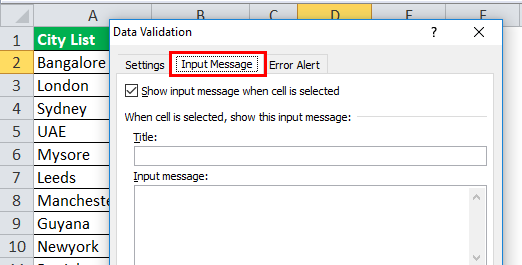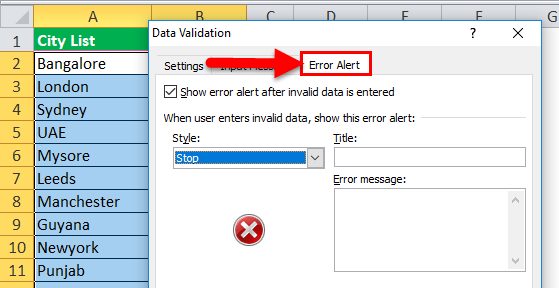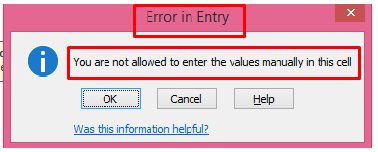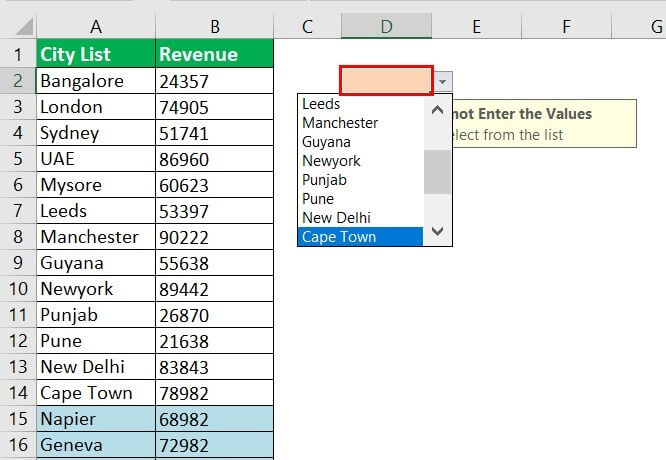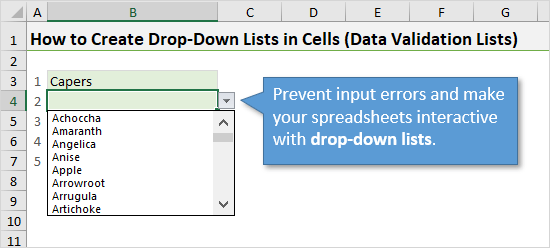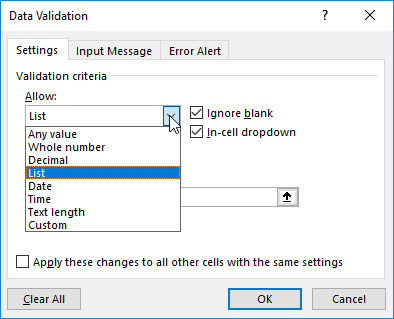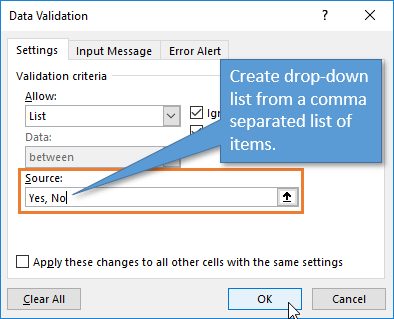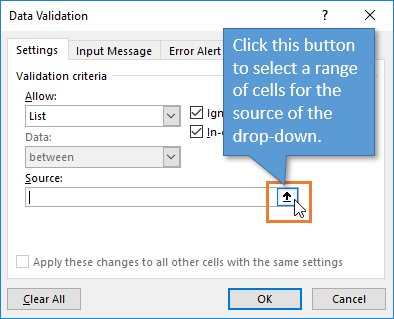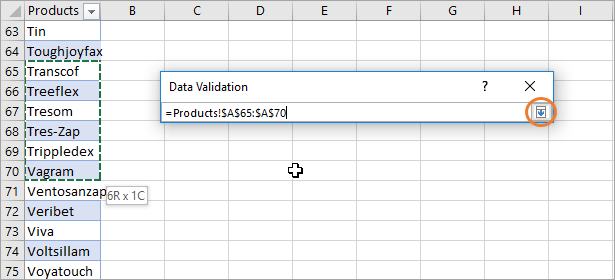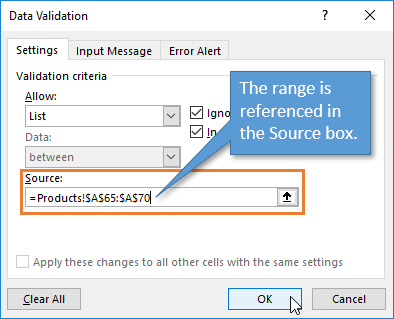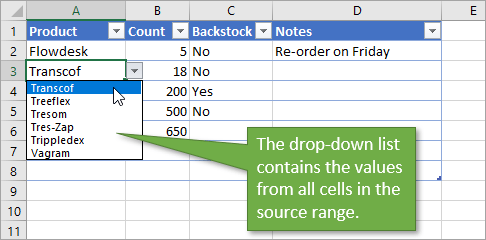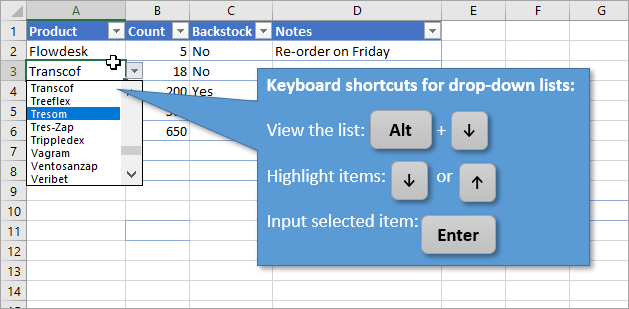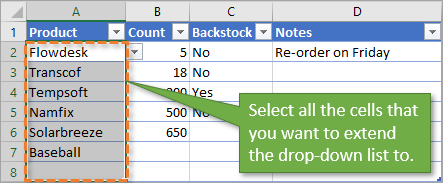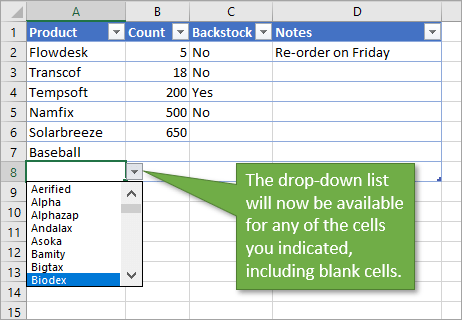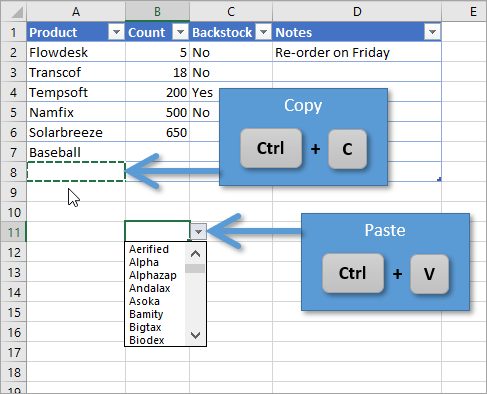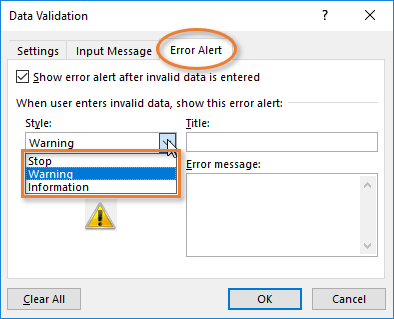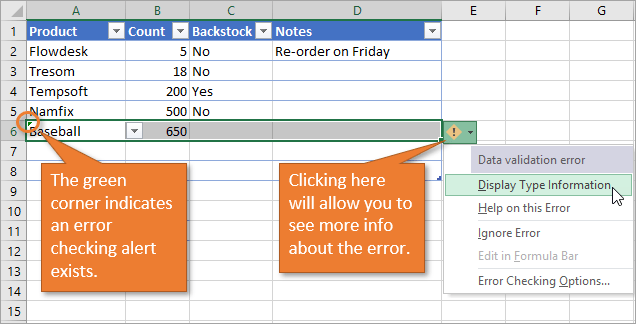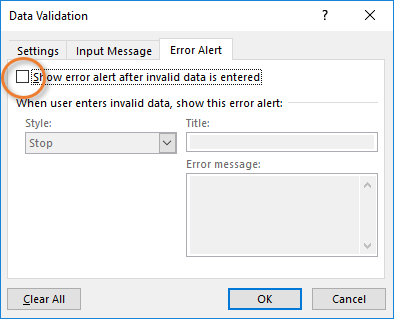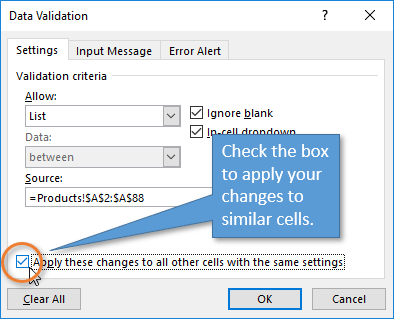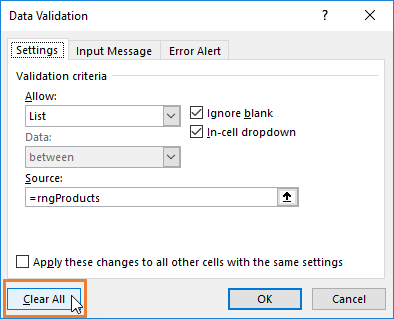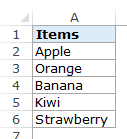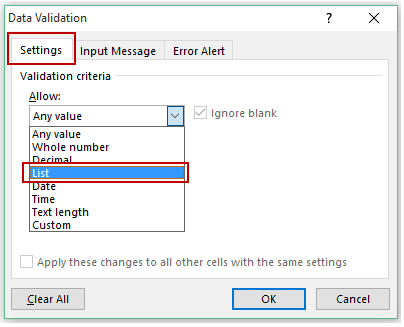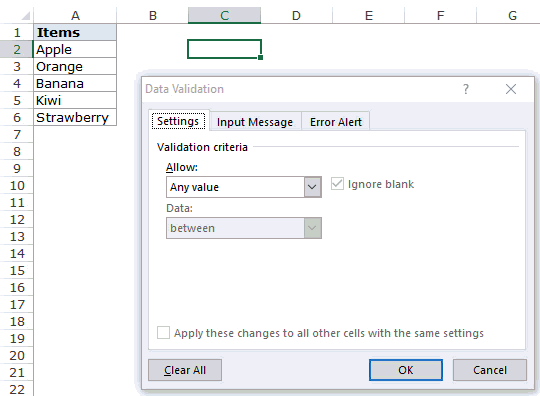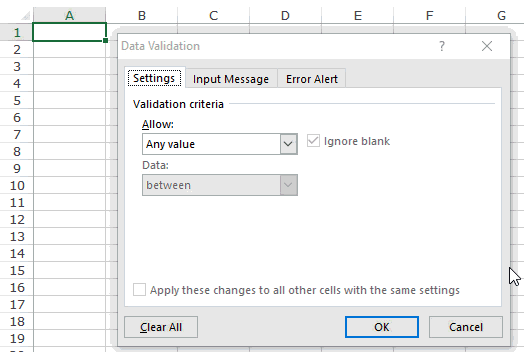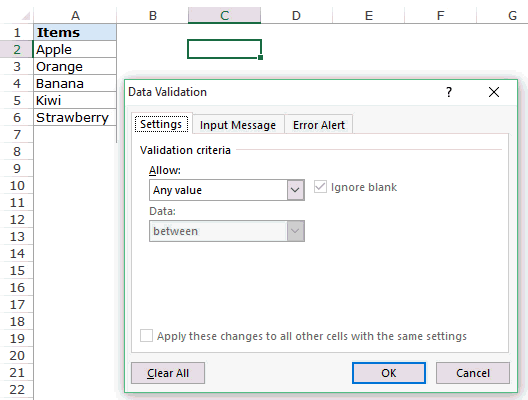Create a drop-down list
You can help people work more efficiently in worksheets by using drop-down lists in cells. Drop-downs allow people to pick an item from a list that you create.
-
In a new worksheet, type the entries you want to appear in your drop-down list. Ideally, you’ll have your list items in an
Excel table
. If you don’t, then you can quickly convert your list to a table by selecting any cell in the range, and pressing
Ctrl+T
.Notes:
-
Why should you put your data in a table? When your data is in a table, then as you
add or remove items from the list
, any drop-downs you based on that table will automatically update. You don’t need to do anything else. -
Now is a good time to
Sort data in a range or table
in your drop-down list.
-
-
Select the cell in the worksheet where you want the drop-down list.
-
Go to the
Data
tab on the Ribbon, then
Data Validation
.Note:
If you can’t click
Data Validation
, the worksheet might be protected or shared.
Unlock specific areas of a protected workbook
or stop sharing the worksheet, and then try step 3 again. -
On the
Settings
tab, in the
Allow
box, click
List
. -
Click in the
Source
box, then select your list range. We put ours on a sheet called Cities, in range A2:A9. Note that we left out the header row, because we don’t want that to be a selection option: -
If it’s OK for people to leave the cell empty, check the
Ignore blank
box. -
Check the
In-cell dropdown
box. -
Click the
Input Message
tab.-
If you want a message to pop up when the cell is clicked, check the
Show input message when cell is selected
box, and type a title and message in the boxes (up to 225 characters). If you don’t want a message to show up, clear the check box.
-
-
Click the
Error Alert
tab.-
If you want a message to pop up when someone enters something that’s not in your list, check the
Show error alert after invalid data is entered
box, pick an option from the
Style
box, and type a title and message. If you don’t want a message to show up, clear the check box.
-
-
Not sure which option to pick in the
Style
box?-
To show a message that doesn’t stop people from entering data that isn’t in the drop-down list, click
Information
or Warning. Information will show a message with this icon
and Warning will show a message with this icon
. -
To stop people from entering data that isn’t in the drop-down list, click
Stop
.Note:
If you don’t add a title or text, the title defaults to «Microsoft Excel» and the message to: «The value you entered is not valid. A user has restricted values that can be entered into this cell.»
-
You can download an example workbook with multiple data validation examples like the one in this article. You can follow along, or create your own data validation scenarios.
Download Excel data validation examples
.
Data entry is quicker and more accurate when you restrict values in a cell to choices from a drop-down list.
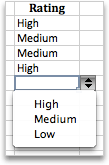
Start by making a list of valid entries on a sheet, and sort or rearrange the entries so that they appear in the order you want. Then you can use the entries as the source for your drop-down list of data. If the list is not large, you can easily refer to it and type the entries directly into the data validation tool.
-
Create a list of valid entries for the drop-down list, typed on a sheet in a single column or row without blank cells.
-
Select the cells that you want to restrict data entry in.
-
On the
Data
tab, under
Tools
, click
Data Validation
or
Validate
.Note:
If the validation command is unavailable, the sheet might be protected or the workbook may be shared. You cannot change data validation settings if your workbook is shared or your sheet is protected. For more information about workbook protection, see
Protect a workbook
. -
Click the
Settings
tab, and then in the
Allow
pop-up menu, click
List
. -
Click in the
Source
box, and then on your sheet, select your list of valid entries.The dialog box minimizes to make the sheet easier to see.
-
Press RETURN or click the
Expand
button to restore the dialog box, and then click
OK
.Tips:
-
You can also type values directly into the
Source
box, separated by a comma. -
To modify the list of valid entries, simply change the values in the source list or edit the range in the
Source
box. -
You can specify your own error message to respond to invalid data inputs. On the
Data
tab, click
Data Validation
or
Validate
, and then click the
Error Alert
tab.
-
See also
Apply data validation to cells
-
In a new worksheet, type the entries you want to appear in your drop-down list. Ideally, you’ll have your list items in an
Excel table
.Notes:
-
Why should you put your data in a table? When your data is in a table, then as you
add or remove items from the list
, any drop-downs you based on that table will automatically update. You don’t need to do anything else. -
Now is a good time to
Sort your data in the order you want it to appear
in your drop-down list.
-
-
Select the cell in the worksheet where you want the drop-down list.
-
Go to the
Data
tab on the Ribbon, then click
Data Validation
. -
On the
Settings
tab, in the
Allow
box, click
List
. -
If you already made a table with the drop-down entries, click in the
Source
box, and then click and drag the cells that contain those entries. However, do not include the header cell. Just include the cells that should appear in the drop-down. You can also just type a list of entries in the
Source
box, separated by a comma like this:
Fruit,Vegetables,Grains,Dairy,Snacks
-
If it’s OK for people to leave the cell empty, check the
Ignore blank
box. -
Check the
In-cell dropdown
box. -
Click the
Input Message
tab.-
If you want a message to pop up when the cell is clicked, check the
Show message
checkbox, and type a title and message in the boxes (up to 225 characters). If you don’t want a message to show up, clear the check box.
-
-
Click the
Error Alert
tab.-
If you want a message to pop up when someone enters something that’s not in your list, check the
Show Alert
checkbox, pick an option in
Type
, and type a title and message. If you don’t want a message to show up, clear the check box.
-
-
Click
OK
.
After you create your drop-down list, make sure it works the way you want. For example, you might want to check to see if
Change the column width and row height
to show all your entries. If you decide you want to change the options in your drop-down list, see
Add or remove items from a drop-down list
. To delete a drop-down list, see
Remove a drop-down list
.
Need more help?
You can always ask an expert in the Excel Tech Community or get support in the Answers community.
See also
Add or remove items from a drop-down list
Video: Create and manage drop-down lists
Overview of Excel tables
Apply data validation to cells
Lock or unlock specific areas of a protected worksheet
Need more help?
Want more options?
Explore subscription benefits, browse training courses, learn how to secure your device, and more.
Communities help you ask and answer questions, give feedback, and hear from experts with rich knowledge.
We have all used tables in Excel, but what if you are looking to make this table into a list for others to use?
You can easily allow users to choose an item from a pre-defined list, by using a dropdown list in Excel.
These types of lists are great for user input.
This is also a great way to ensure that only valid data is entered into a cell.
When you are creating a dropdown list Excel allows you to tailor it to your needs in a variety of ways.
An Excel drop down list is comparable to the dropdown menus that one often sees on forms or webpages.
How to create a drop down list in Excel, is covered in our Advanced Excel training course.
Why Use A Drop Down List?
Drop down lists help you to organise your data and limit the amount of entries people can make to each cell.
Whenever you create an Excel spreadsheet for a user to input data, a drop down list will be very helpful!
They help you to streamline the experience you are creating for your users, and design a smooth looking document for them to use.
We will cover everything about how you can make a drop down list here.
Create A Drop Down List Using A Cell Range
In the example below, we have a worksheet called Products containing the names of products. This is the original sheet that contains the source data.
1. Now select or create another sheet. In this case, this is the destination sheet where you would like the drop down list to be. This sheet is called ProductsDropDownList in our example.
2. Select cell E5 on the destination sheet. This is the cell that is going to have the drop down list. Go to the Data Tab on the ribbon and on the Data Tools group, choose Data Validation.
3. The Data Validation Dialog Box will appear. Under the Settings tab, in the Allow drop down menu click List. Ensure Ignore blank and In-cell dropdown are checked.
Using the Source box, select the cell range on the Products sheet, which in this case is range A2:A9.
4. Click Ok.
5. The drop down list is shown below.
• Note: If the user tries to type a value in the cell that is not in the drop down list, they will get an error message.
• Note: The drop down box arrow in Excel is only shown when the cell containing the drop down list is selected.
• Tip: By default, the items in the actual list are quite small. If you’d like the entries in the list to look bigger then in the worksheet containing the drop down list, click the Select All button to select all the cells.
With all the cells selected decrease the font size by one point. Then increase the zoom level magnification.
In the example below 140% zoom level magnification was used and the items in the dropdown list now look bigger.
If you’d like to know more about increasing or decreasing font size in Excel then read our guide on Excel font formatting.
• Tip: By default, the items in the list will appear in the same order that they are entered in the original worksheet. If you’d like to have the items in your list sorted in either ascending or descending order, go to your source data.
Then with one cell in the range selected, go to the Data Tab, in the Sort & Filter group choose either ascending sort or descending sort.
In the example below, ascending sort was selected. The items in the drop down list are now sorted in alphabetical order.
• Tip: You can hide, or password protect the worksheet that contains the source data if you don’t want people to accidentally edit or remove items in your dropdown list.
• Tip: You can allow the user to enter another item that is not in the list, when necessary. To do this select the cell containing the drop down list.
Go to the Data Tab on the ribbon and on the Data Tools group, choose Data Validation and in the Error Alert Tab uncheck the check box that says Show error alert after invalid data is entered. Click Ok.
Add an item to a drop down list
You may have a situation where you want to add a product that is not in the original list.
1. To do this, go to the original sheet containing the names of the products. Select one of the products.
2. Right-click the cell and select Insert.
3. Select the Shift cells down option. Click Ok.
Once you have done this you will see the the following.
4. Enter a new product name.
5. Now when you return to your sheet with your drop down menu, you should see the list has been updated.
Delete an item from a drop down list
You may have a situation where you want to delete a product from the drop down menu.
1. To do this, go to the original sheet containing the names of the products. Select the item that you want to be deleted from your drop down menu.
2. Right-click the cell and select Delete.
3. Select the Shift cells up option. Click Ok.
Once you have done this you will see the the following.
4. This item should no longer be in the drop down menu.
Remove the drop down list
To remove a drop down menu Excel lets you do this in two main ways.
• Select the cell with the drop down list. Go to the Data Tab on the ribbon and from the Data Tools group, choose Data Validation.Under the Settings tab, click Clear All and then OK. The drop down list will be removed from the cell.
Once you have done this you will see the the following.
• You can also remove the drop down list by selecting the cell with the drop down list and then going to the Editing group in the Home Tab. Click the arrow next to the Clear button and select Clear All.
Once you have done this you will see the the following.
Once you have done this you will see the following.
Remove all the drop down lists in a worksheet
If you would like to remove all the drop down lists in your worksheet then you can do the following.
1. With any cell in the worksheet selected, go to the Home tab and in the Editing group click on Find and Select. Choose Go to Special…
2. Select Data Validation and choose All. Click Ok.
Once you have done this you will see the following.
3. On the Home Tab, in the Editing Group, click the arrow next to the Clear button and select Clear All.
4. Now all the drop down lists will be removed.
• Note: This will remove all the data validation (not only drop down lists) from your worksheets.
Create a simple drop down list by entering the data manually
You can manually enter the source data for the drop down list by using the Source box.
1. Select the cell which you would like to contain the drop down list.
2. Go to the Data Tab and choose Data Validation from the Data Tools group. Select List and this time in the Source box manually type the entries as shown below. Make sure that each entry is separated by a comma.
3. Click Ok.
• Note: You can manually enter as many entries as you’d like but it makes sense to only use the manual entry option when you have a few options in case you need to sort the list for example.
Create a simple drop down list by using a named range
You can use a named range as your source for your drop down menu.
1. Create a named range first. Select the range of cells that you would like to name.
2. Type the name Attendees into the Name Box and press Enter.
3. In a cell, on the sheet where you would like your drop down list to be, follow the same steps to create a simple drop down list.
However, in the Source box type an equals sign first and then the name of your named range.
4. Click Ok.
Dynamic drop down lists
A dynamic drop down list refers to a list that updates automatically as an item is added in the original data set.
Dynamic drop down lists are great for when you want to add new items and have it update automaticaly!
If you need to create a dynamic list excel provides a few ways to do this. We will cover them all here!
Create a dynamic drop down list using a formula
We have a worksheet containing the source data called DynamSourceData and a destination sheet called DynamicDropDownList.
1. Select cell B5 in the destination worksheet and go to the Data Tab and choose Data Validation from the Data Tools group. Select List and in the Source box, enter the following formula:
=OFFSET(DynamSourceData!$A$1,0,0,COUNTA(DynamSourceData!$A:$A),1)
2. Click Ok.
3. Now go to the worksheet containing the source data and add the colour Blue.
4. You will see that the drop down list on the destination worksheet is updated.
• Tip: Sometimes when building formulas, you may get errors.
To provide more insight into what is causing the error and how to fix it, copy the formula to a cell in Excel and go to the Formulas Tab and then the Formula Auditing group. Click on Error Checking.
To learn more about Formula Auditing, view our detailed guide on formula auditing in Excel here.
Create a dynamic drop down list by using Table Formatting
When creating this specific dynamic drop down list Excel requires you to format your source data as a table. We have a sheet containing the names of popular sports and we would like to create a dynamic drop down list on the destination sheet.
1. Select a cell in the source data range. It can be any cell in the source data range, but in this case cell A2 is selected.
2. On the Home Tab, in the Styles group, click Format as Table.
3. Choose a table style.
4. The Create Table Dialog Box will appear. Ensure the My table has headers box is checked. Click Ok. This automatically creates a table from your range.
You should see the following.
5. With a cell in the Table still selected, go to Table Tools and in the Table Design Tab, in the Properties group rename the table to SportsT.
6. Now on the destination sheet in cell B4, go to the Data Tab and choose Data Validation from the Data Tools group. Select List and in the Source box enter the following formula
=INDIRECT(“SportsT[Sports]”)
Since we are using a table, we can use structured references in our formula.
You should see the following.
7. Now as entries are added or deleted in the SportsT table, the drop down list is automatically updated to reflect these changes.
You should see the following.
Create a dynamic drop down list by using the UNIQUE Function
Let’s say you have a situation where you have an existing table like the one shown below.
We’d like to create a dynamic drop down list using the source data in column B. However, as you can see there are a lot of duplicates and we need unique values.
We can use the UNIQUE Function in order to do this. The UNIQUE Function is one of the new dynamic array functions available in Office 365.
• Extract the items for the unique list
1. We need to extract the unique cities from our table which is named CompanyT. So, in cell D1 enter the following formula
=UNIQUE(CompanyT[Company Headquarters])
2. Once you press the Enter key, all the unique values are extracted and the results spill into the needed cells as shown below.
• Setup Data Validation
3. Now while still on the same worksheet, with cell H1 selected go to the Data Tab and in the Data Tools Group, select Data Validation.
4. Select List. In the Source box enter
=$D$1#
This is the way you need to refer to a cell that spills over. Click Ok.
5. You now have a dynamic drop down list that updates as values are added to column B but only with unique values.
6. If another company entered their company headquarters as Leeds, the dynamic drop down list would not add Leeds again. However, if they entered their company headquarters as Honolulu then the dynamic drop down list would update with this value.
Dependent drop-down lists
A dependent drop down list is a new drop down list, which is based on the value taken from another drop down list.
This may seem complicated but it is simple in practice – take a look below!
Create a simple dependent drop-down list
In this example, attendees attending an event need to select whether they want a savoury snack for lunch or a sweet snack. If the attendee selects the savoury option, they get three choices.
However, if they select the sweet option then they get three other choices.
The first thing we need to do is create named ranges. So, select the range B3:E4.
1. Go to the Formulas Tab, and in the Defined Names group choose Create from Selection.
2. Ensure that only the Left Column option is checked in the Create Names from Selection Dialog Box since the data is horizontally arranged and click Ok.
3. Now go to Name Manager and you should see the two named ranges Savoury and Sweet.
4. Now with cell B7 selected, go to the Data Tab on the ribbon and on the Data Tools group, choose Data Validation. Under Settings select List. Using the Source box select the cell range B3:B4. Click Ok.
5. Select one of the options either savoury or sweet.
6. With cell C7 selected, go to the Data Tab select Data Validation from the Data tools group. Under Settings select List. In the Source box enter the formula:
=INDIRECT(B7)
7. Click Ok. Now if the user selects savoury from the drop-down box in cell B7, they get the savoury options when they click the drop down in cell C7. When they select sweet in cell B7 they get the sweet options in cell C7.
Conclusion
It is advisable to know how to create a drop-down box in Excel to visually enhance your own sheets and dashboards, speed up data entry and reduce the chance of errors.
If you need to create a dropdown list Excel provides ways to not only create a standard drop down list but also to create other kinds of drop down lists.
This guide has given a comprehensive overview of some of the options you have for creating a dropdown list in Excel.
A drop-down list in excel is a pre-defined list of inputs that allows users to select an option. In simple terms, the response that the user can submit is limited to the options presented by the drop-down list. This prevents the user from typing manual entries, thereby reducing the occurrence of a garbage value in the data.
For example, to answer a set of questions in an online survey, the options provided in the drop-down list are “yes” and “no.” The user is expected to select any one of these answers. This prevents the user from selecting options other than the listed ones.
In the absence of a drop-down excel list, there are chances of typing an incorrect response in the data file. For example, the name “Ravish,” is incorrectly typed as “Ravish ,” with an extra space at the end. Such cell entries return an error on applying the formula in Excel. The usage of the drop-down list ensures that the input matches the correct spelling.
In Excel, the user can create/add a drop-down list using the following ways:
- With “data validation”
- With “Form controlExcel Form Controls are objects which can be inserted at any place in the worksheet to work with data and handle the data as specified. These controls are compatible with excel and can create a drop-down list in excel, list boxes, spinners, checkboxes, scroll bars.read more” combo box
- With “ActiveX control” combo box
This article discusses the creation of a drop-down list using the “data validation” option.
Table of contents
- What is Drop-Down List in Excel?
- How to Create/Add a Drop-Down List in Excel?
- Example #1–Static Drop-Down List
- Example #2–Dynamic Drop-Down List
- Benefits of a Drop-Down List in Excel
- Frequently Asked Questions (FAQs)
- Recommended Articles
- How to Create/Add a Drop-Down List in Excel?
How to Create/Add a Drop-Down List in Excel?
You can download this Drop Down List Excel Template here – Drop Down List Excel Template
The drop-down list is also known by the name “data validationThe data validation in excel helps control the kind of input entered by a user in the worksheet.read more.” The following image shows the “data validation” option under the Data tab.
Let us understand how to create a drop-down list with the help of the following examples.
Example #1–Static Drop-Down List
The succeeding table provides the names of cities in column A. The revenue earned by the different offices of an organization is shown in column B. We want to create a drop-down list of the cities in the cell D2.
The steps to create/add the static drop-down list in Excel are stated as follows:
- Select cell D2 in the Excel sheet.
- Click “data validation” drop-down from the Data tab of Excel. Choose the option “data validation,” as shown in the image below.
Alternatively, use the shortcut key “Alt+A+V+V” to access the “data validation” dialog box.
- The “data validation” window appears as shown in the succeeding image.
- In the Settings tab, choose “list” from the drop-down menu of the “allow” option.
- Select the range of cities in the “source” box, as shown in the succeeding image.
- Click “Ok” to create the drop-down list in the cell D2. The output is shown in the following image.
- Enter a value in cell D2. It shows the result, “the value you entered is not valid.”
- In Excel, we can modify the message displayed to the users on entering manual values. For this, select cell D2. Press the shortcut key “Alt+A+V+V” to access the “data validation” box. Click the “input message” tab.
- Type “you cannot enter the values” in the “title” box and “please select from the list” in the “input message” box. Click “Ok.”
- On selecting cell D2, the user will view the information entered in step 9, as shown in the following image.
- Select cell D2 and press the shortcut key “Alt+A+V+V” to access the “data validation” window. Click the “error alert” tab.
- Select any one icon among the following “style” options.
• Information
• Warning
• StopThe succeeding image shows the specified style icons.
We have chosen the “information” icon.
- In the “title” box, type “error in entry.” In the “error message” box, type “you are not allowed to enter the values manually in this cell.” Click “Ok.”
- On entering the data manually, the error message created in the step 13 is displayed, as shown in the following image.
Example #2–Dynamic Drop-Down List
A dynamic drop-down list extends on adding entries to the source range. It is formed as the number of entries at the end of the list increases. It can be created using the Excel tablesIn excel, tables are a range with data in rows and columns, and they expand when new data is inserted in the range in any new row or column in the table. To use a table, click on the table and select the data range.read more and the INDIRECT functionThe INDIRECT excel function is used to indirectly refer to cells, cell ranges, worksheets, and workbooks.read more.
Working on the data of example #1, let us add the names of two more cities, Napier and Geneva, at the end of the list. Create a dynamic drop-down list in cell D5.
The following table shows the updated list of cities and the revenue earned by the different offices of an organization in columns A and B, respectively.
The drop-down list in cell D2 lists data up to the city Cape Town. It does not show the data for the two additional cities shown in the following image.
To update the drop-down list, we need to create named ranges in Excel. The steps to create named rangesName range in Excel is a name given to a range for the future reference. To name a range, first select the range of data and then insert a table to the range, then put a name to the range from the name box on the left-hand side of the window.read more are listed as follows:
Step 1: Click “name manager” in the Formulas tab of Excel.
Step 2: Select the “new” option in the “name manager” window.
Step 3: The “new name” window opens. Type “drop_down_list” in the “name” box and apply the formula in “refers to” box, as shown in the image. Click “Ok.”
Step 4: Select cell D5 and press the shortcut key “Alt+A+V+V” to access the “data validation” window. Choose “list” in the “allow” option of the “data validation” window.
Step 5: In the “source” box, enter the name typed in the “name” box in step 3.
Note: Alternatively, use the shortcut key “Ctrl+F3” to access the “name manager.” From this, the user can enter the desired name for the list.
Step 6: Enter the two cities, Haryana and Colombo at the end of the list. Click the drop-down list in column D.
Thus, in the dynamic drop-down list, the user can view the updated list of cities.
The succeeding image shows the dynamic drop-down list with the updated cities.
Benefits of a Drop-Down List in Excel
The benefits of using the Excel drop-down list are stated as follows:
- The user can select an entry from a range of values, instead of entering manual responses.
- The drop-down list can be copied and pasted to any of the cells in the worksheet.
- A dependent drop-down list helps meet the specific requirement.
Frequently Asked Questions (FAQs)
1. Define a drop-down list in Excel and state the benefits of creating it.
The drop-down list contains pre-defined inputs or parameters for a user to choose from. It is a data validation function where a user is expected to choose an entry from the limited responses.
A drop-down list can be static or dynamic.
• A static drop-down list is created when the number of choices is limited and not much change is expected in the entries over time.
• A dynamic drop-down list is used when there is a long list of choices, and the entries undergo a change over time.
The benefits of the drop-down list include:
1. It improves the accuracy of the input entries.
2. It occupies less space in the worksheet and contains a lot of information.
3. It prevents the users from typing manual entries.
4. The dependent drop-down list meets the specific requirements of the user.
2. How to create/add a drop-down list in Excel?
The following steps help to create a drop-down list in Excel:
1. Create a vertical list of options from which the users need to choose.
2. Select a specific cell in Excel to create the drop-down list. (The user can create a drop-down list in a single cell or multiple cells.)
3. Choose “data validation” from the Data tab of the Excel ribbon.
4. Select “list” from the drop-down list of the “allow” option.
5. Click the “source” option and enter the range of cells containing the vertical list of options (created in step 1) in Excel. The range reference is displayed in the “source” box.
6. Click “Ok.”
The user can view the drop-down list in the specific cell.
3. What is a dependent drop-down list in Excel?
In a dependent drop-down list, a list of values of one drop-down list depends on a value in another drop-down list.
For example, if the user selects the option “cuisine” in one drop-down list, the cuisine types in the succeeding drop-down list are displayed. This cuisine type is presented by options like “Chinese,” “Thai,” “Italian,” and “Greek.”
It can be created with the help of the INDIRECT function and the named ranges.
4. What is a cascading drop-down list?
A cascading drop-down list is a chain of dependent drop-down list controls. Here, one drop-down list is controlled by the previous (or parent) drop-down list.
An entry in a drop-down list control is populated based on a new entry chosen from another drop-down list control.
Recommended Articles
This has been a step-by-step guide to the drop-down list in Excel. Here we discuss how to create a drop-down list (static and dynamic list) using examples and downloadable templates. You may also look at these useful Excel tools –
- How to Edit Drop-Down List?
- Excel Drag and DropExcel Drag and Drop, also known as “Fill Handle”, is the PLUS (+) icon that appears when we move mouse or cursor to the right bottom of the selected cell. Using this plus icon we can drag to the left, to the right, to the top and also to the bottom from the active cell. read more
- Calendar Drop-Down in ExcelThe calendar drop-down in Excel is an effective way of ensuring correct data entry and records, and it can be created with the data validation option to ensure error-free use.read more
- Scroll Bars in ExcelIn Excel, there are two scroll bars: one is a vertical scroll bar that is used to view data from up and down, and the other is a horizontal scroll bar that is used to view data from left to right.read more
Bottom Line: The complete Excel guide on how to create drop-down lists in cells (data validation lists). Includes keyboard shortcuts to select items, copying drop-downs to other cells, handling invalid inputs, updating lists with new items, and more.
Skill Level: Beginner
Download the Excel File
You can download the file I’m using in the video here:
What Are Data Validation Lists?
Creating a drop-down list is a great way to ensure that entries are uniform and free from spelling errors. It also helps restrict entries so that only values you’ve approved make it onto the sheet.
That’s why they are also called data validation lists. They help to make sure that only valid data makes it into the cells that you’ve applied it to.
This can be helpful when multiple users are entering data on the same sheet and you want the options to be limited to a list of items or values that you’ve already approved.
We can also use drop-down lists to create interactive reports and financial models, where results change when the user changes a cell’s value.
How to Create a Drop-down (Data Validation) List
To create a drop-down list, start by going to the Data tab on the Ribbon and click the Data Validation button.
The Data Validation window will appear. The keyboard shortcut to open the Data Validation window is Alt, A, V, V.
You’ll want to select List in the drop-down menu under Allow.
At this point there are a few ways that you can tell Excel what items you want to include in your drop-down list.
Drop-down List from Comma Separated Values
The first way is by typing all of the options that you want in your drop-down list, separated by commas, into the Source field. For example, if there are only two options to choose from, such as Yes and No, you would simply type “Yes, No” (do not include the quotation marks) in the Source box. It doesn’t matter whether a space follows your comma or not.
A longer list of options might look like this: “Red, Blue, Green, Purple, Orange, Yellow, Brown”. The options in your drop-down list will appear in the exact same order that you have typed them.
Note: On some language versions of Excel you will need to use a semicolon (;) instead of a comma.
Drop-down List from a Range of Values
The second way to fill your list with options is to choose them from a range of values. To do this, instead of typing values into the Source field, you want to select the icon to the right.
Selecting this icon will open up a small window that will auto-fill when you select a range of cells on the worksheet. Once you’ve selected the values you want to appear in your drop-down list, you can click on the corresponding icon to take you back to the Data Validation window.
At this point, the range you’ve selected will show in the Source box and you can just hit OK.
Now the values in the range that you’ve selected show as options that you can choose from in your drop-down list.
Shortcut for Selecting from the Drop-down List
To choose the option you want from your drop-down list, you can use your mouse to click on the option you want. Another way to select it is to use the keyboard shortcut Alt+?. This brings up the drop-down list and you can use your up and down arrow keys to highlight the selection you want, and then press Enter to select.
How to Search the Drop-down List
Unfortunately, Excel doesn’t have an option to search the drop-down list for a particular item, but I’ve created an add-in that gives you that option. It’s called List Search and you can access that add-in here:
Click here to download the List Search Add-in
Note: You will create a free account for the Excel Campus Members site to access the download and any future updates. The download site also contains installation instructions and videos.
How to Copy the Data Validation List to Other Cells
If you have created a drop-down list for a particular cell and would like other cells to have the same data validation list, you can easily copy (extend) that list to other cells.
Start by clicking on the cell that has the list, and then select any additional cells that you want to extend the drop-down list to. This can include blank cells or cells that already have values in them.
As before, you will click on the Data Validation button in the Data tab, but this time a warning will appear that says, “The selection contains some cells without Data Validation settings. Do you want to extend the Data Validation to these cells?”
Choose Yes, and then hit OK when the Data Validation Window appears. You’ll see that each of the cells in your selection now has the same drop-down options as the original cell.
It’s also worth noting that you can copy and paste Data Validation from one cell to another just as you would copy and paste normal values and formatting.
Handling Errors and Invalid Inputs
What happens when we enter a value into a cell that has a Data Validation List, but that value is not one of the options in the list? That depends on the Error Alert settings, which we have control of.
To change the kind of message the user receives when they enter an extraneous value, you can go back to the Data Validation window. Under the Error Alert tab, you can find three options: Stop, Warning, and Information.
You’ll also notice that there are fields where you can change the title of the error message and the text of the message itself, so that when the user enters data that’s not part of your validation list, they will receive an alert that’s worded in the way you want it to appear.
Here is an explanation of each Error Alert Style:
Stop Style
When the user types an invalid entry, an error message will appear that gives the option to either retype the entry or cancel the attempt. The message looks like this:
Warning Style
The Warning style displays a message that gives the user a choice to allow an entry that isn’t on the preset list.
Information Style
The Information style displays a message that automatically allows the entry no matter what the value is. The user is presented with informative text about validation rules.
Error Checking Alert
When any invalid entry is made in a cell, the error checking alert will appear in the cell. The error is indicated with the green triangle in the top-left corner of the cell. Clicking the Error Box button will allow you to see more info about data validation error. You can select “Display Type Information” from the list to see the cause of the error.
Disable Error Alerts
Another option under the Error Alert tab is to uncheck the box that says, “Show error alert after invalid data is entered.” This allows any value to be entered into the cell, and no message box will appear.
Adding New Data to the Source Range of the List
Adding new options to our drop-down list is possible, but it isn’t automatic when we add new items the bottom of our source list. We need to tell Excel what our new extended source range is. You can do that in the Data Validation window by just typing in the new range, or re-selecting the range to include the new data. (See the section above entitled “Create a Drop-Down List from a Range of Values” for how to select your range.)
The great thing is that we don’t have to redefine these settings for each cell that has Data Validation. The “Apply these changes to all other cells with the same settings” checkbox does this for us. When you click the checkbox, the other cells will selected in the background. This gives you a visual indication of what will be updated.
Then press OK. Any cells that shared the same data validation settings will now include the updated changes that you’ve made.
There is a way to automate the process so that any change you make to the source data instantly updates your drop-down list. It involves using Excel tables and named ranges. You can find out how in this post:
How to Add New Rows to Drop-down Lists Automatically – Dynamic Data Validation Lists
Removing Data Validation from a Cell
Getting rid of a Data Validation list is simple. Open the Data Validation window and click the Clear All button.
If you want to clear the validation settings from other cells with the same settings, make sure to click that checkbox before hitting the Clear All button.
Make Your Workbooks Interactive
Data Validation lists are a great tool to add to your Excel toolbelt. They help us keep our data clean and make our spreadsheets easier to use. We can use them as the source of lookup formulas to create interactive financial models and reports. I will do some follow-up posts with these techniques as well.
Once you feel comfortable with drop-down lists, you may want to try dependent (also called cascading) lists. These are lists that change depending on what you’ve already chosen in another list. For example, you may create a list of car brands, like Toyota, Ford, and Honda. Then you can have a second list of car models that populates with specific options depending on what you choose in the first list. If you choose Toyota in the first list, you might see Corolla, Camry, and Tacoma in the second. But if you go back to the first list and choose Ford, the options in the second list can change to Mustang, Explorer, and Focus. Learn how to create dependent cascading lists here.
If you have any questions or comments about how to use drop-down lists, don’t hesitate to leave a comment below. Thanks! 😊
A drop-down list is an excellent way to give the user an option to select from a pre-defined list.
It can be used while getting a user to fill a form, or while creating interactive Excel dashboards.
Drop-down lists are quite common on websites/apps and are very intuitive for the user.
Watch Video – Creating a Drop Down List in Excel
In this tutorial, you’ll learn how to create a drop down list in Excel (it takes only a few seconds to do this) along with all the awesome stuff you can do with it.
How to Create a Drop Down List in Excel
In this section, you will learn the exacts steps to create an Excel drop-down list:
- Using Data from Cells.
- Entering Data Manually.
- Using the OFFSET formula.
#1 Using Data from Cells
Let’s say you have a list of items as shown below:
Here are the steps to create an Excel Drop Down List:
- Select a cell where you want to create the drop down list.
- Go to Data –> Data Tools –> Data Validation.
- In the Data Validation dialogue box, within the Settings tab, select List as the Validation criteria.
- As soon as you select List, the source field appears.
- As soon as you select List, the source field appears.
- In the source field, enter =$A$2:$A$6, or simply click in the Source field and select the cells using the mouse and click OK. This will insert a drop down list in cell C2.
- Make sure that the In-cell dropdown option is checked (which is checked by default). If this option in unchecked, the cell does not show a drop down, however, you can manually enter the values in the list.
- Make sure that the In-cell dropdown option is checked (which is checked by default). If this option in unchecked, the cell does not show a drop down, however, you can manually enter the values in the list.
Note: If you want to create drop down lists in multiple cells at one go, select all the cells where you want to create it and then follow the above steps. Make sure that the cell references are absolute (such as $A$2) and not relative (such as A2, or A$2, or $A2).
#2 By Entering Data Manually
In the above example, cell references are used in the Source field. You can also add items directly by entering it manually in the source field.
For example, let’s say you want to show two options, Yes and No, in the drop down in a cell. Here is how you can directly enter it in the data validation source field:
This will create a drop-down list in the selected cell. All the items listed in the source field, separated by a comma, are listed in different lines in the drop down menu.
All the items entered in the source field, separated by a comma, are displayed in different lines in the drop down list.
Note: If you want to create drop down lists in multiple cells at one go, select all the cells where you want to create it and then follow the above steps.
#3 Using Excel Formulas
Apart from selecting from cells and entering data manually, you can also use a formula in the source field to create an Excel drop down list.
Any formula that returns a list of values can be used to create a drop-down list in Excel.
For example, suppose you have the data set as shown below:
Here are the steps to create an Excel drop down list using the OFFSET function:
This will create a drop-down list that lists all the fruit names (as shown below).
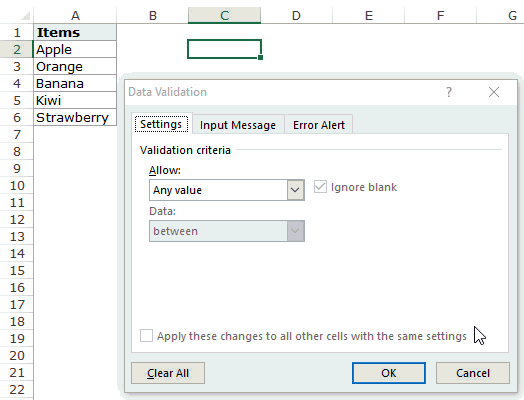
How this formula Works??
In the above case, we used an OFFSET function to create the drop down list. It returns a list of items from the ra
It returns a list of items from the range A2:A6.
Here is the syntax of the OFFSET function: =OFFSET(reference, rows, cols, [height], [width])
It takes five arguments, where we specified the reference as A2 (the starting point of the list). Rows/Cols are specified as 0 as we don’t want to offset the reference cell. Height is specified as 5 as there are five elements in the list.
Now, when you use this formula, it returns an array that has the list of the five fruits in A2:A6. Note that if you enter the formula in a cell, select it and press F9, you would see that it returns an array of the fruit names.
Creating a Dynamic Drop Down List in Excel (Using OFFSET)
The above technique of using a formula to create a drop down list can be extended to create a dynamic drop down list as well. If you use the OFFSET function, as shown above, even if you add more items to the list, the drop down would not update automatically. You will have to manually update it each time you change the list.
Here is a way to make it dynamic (and it’s nothing but a minor tweak in the formula):
- Select a cell where you want to create the drop down list (cell C2 in this example).
- Go to Data –> Data Tools –> Data Validation.
- In the Data Validation dialogue box, within the Settings tab, select List as the Validation criteria. As soon as you select List, the source field appears.
- In the source field, enter the following formula: =OFFSET($A$2,0,0,COUNTIF($A$2:$A$100,”<>”))
- Make sure that the In-cell drop down option is checked.
- Click OK.
In this formula, I have replaced the argument 5 with COUNTIF($A$2:$A$100,”<>”).
The COUNTIF function counts the non-blank cells in the range A2:A100. Hence, the OFFSET function adjusts itself to include all the non-blank cells.
Note:
- For this to work, there must NOT be any blank cells in between the cells that are filled.
- If you want to create a drop-down list in multiple cells at one go, select all the cells where you want to create it and then follow the above steps. Make sure that the cell references are absolute (such as $A$2) and not relative (such as A2, or A$2, or $A2).
Copy Pasting Drop-Down Lists in Excel
You can copy paste the cells with data validation to other cells, and it will copy the data validation as well.
For example, if you have a drop-down list in cell C2, and you want to apply it to C3:C6 as well, simply copy the cell C2 and paste it in C3:C6. This will copy the drop-down list and make it available in C3:C6 (along with the drop down, it will also copy the formatting).
If you only want to copy the drop down and not the formatting, here are the steps:
This will only copy the drop down and not the formatting of the copied cell.
Caution while Working with Excel Drop Down List
You need to to be careful when you are working with drop down lists in Excel.
When you copy a cell (that does not contain a drop down list) over a cell that contains a drop down list, the drop down list is lost.
The worst part of this is that Excel will not show any alert or prompt to let the user know that a drop down will be overwritten.
How to Select All Cells that have a Drop Down List in it
Sometimes, it ‘s hard to know which cells contain the drop down list.
Hence, it makes sense to mark these cells by either giving it a distinct border or a background color.
Instead of manually checking all the cells, there is a quick way to select all the cells that have drop-down lists (or any data validation rule) in it.
This would instantly select all the cells that have a data validation rule applied to it (this includes drop down lists as well).
Now you can simply format the cells (give a border or a background color) so that visually visible and you don’t accidentally copy another cell on it.
Here is another technique by Jon Acampora you can use to always keep the drop down arrow icon visible. You can also see some ways to do this in this video by Mr. Excel.
Creating a Dependent / Conditional Excel Drop Down List
Here is a video on how to create a dependent drop-down list in Excel.
If you prefer reading over watching a video, keep reading.
Sometimes, you may have more than one drop-down list and you want the items displayed in the second drop down to be dependent on what the user selected in the first drop-down.
These are called dependent or conditional drop down lists.
Below is an example of a conditional/dependent drop down list:
In the above example, when the items listed in ‘Drop Down 2’ are dependent on the selection made in ‘Drop Down 1’.
Now let’s see how to create this.
Here are the steps to create a dependent / conditional drop down list in Excel:
Now, when you make the selection in Drop Down 1, the options listed in Drop Down List 2 would automatically update.
Download the Example File
How does this work? – The conditional drop down list (in cell E3) refers to =INDIRECT(D3). This means that when you select ‘Fruits’ in cell D3, the drop down list in E3 refers to the named range ‘Fruits’ (through the INDIRECT function) and hence lists all the items in that category.
Important Note While Working with Conditional Drop Down Lists in Excel:
- When you have made the selection, and then you change the parent drop down, the dependent drop down would not change and would, therefore, be a wrong entry. For example, if you select the US as the country and then select Florida as the state, and then go back and change the country to India, the state would remain as Florida. Here is a great tutorial by Debra on clearing dependent (conditional) drop down lists in Excel when the selection is changed.
- If the main category is more than one word (for example, ‘Seasonal Fruits’ instead of ‘Fruits’), then you need to use the formula =INDIRECT(SUBSTITUTE(D3,” “,”_”)), instead of the simple INDIRECT function shown above. The reason for this is that Excel does not allow spaces in named ranges. So when you create a named range using more than one word, Excel automatically inserts an underscore in between words. So ‘Seasonal Fruits’ named range would be ‘Seasonal_Fruits’. Using the SUBSTITUTE function within the INDIRECT function makes sure that spaces are converted into underscores.
You May Also Like the Following Excel Tutorials:
- Extract Data from Drop Down List Selection in Excel.
- Select Multiple Items from a Drop Down List in Excel.
- Creating a Dynamic Excel Filter Search Box.
- Display Main and Subcategory in Drop Down List in Excel.
- How to Insert Checkbox in Excel.
- Using a Radio Button (Option Button) in Excel.
- How to Remove Drop-Down List in Excel?


